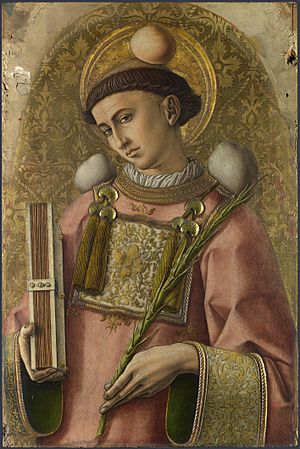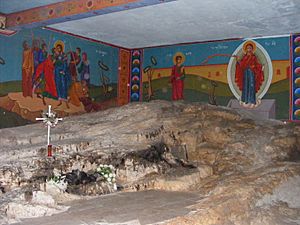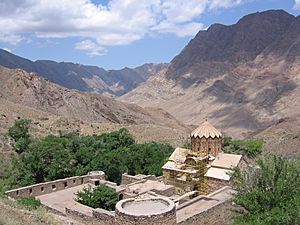Saint Stephen facts for kids
Quick facts for kids SaintStephen |
|
|---|---|

Saint Stephen by Carlo Crivelli
|
|
| Deacon, Archdeacon Apostle of the Seventy Protomartyr of The Faith First Martyr |
|
| Born | 5 AD |
| Died | 33–36 AD (aged 28–32) Jerusalem, Judaea, Roman Empire |
| Venerated in | Roman Catholic Church Eastern Catholic Churches Orthodox Church Oriental Orthodox Churches Assyrian Church of the East Anglican Communion |
| Canonized | Pre-Congregation |
| Feast | 25 December (Armenian Christianity) 26 December (Western) 27 December, 4 January, 2 August, 15 September (Eastern) Tobi 1 (Coptic Christianity) |
| Attributes | Red Martyr, stones, dalmatic, censer, miniature church, Gospel Book, martyr's palm. In Orthodox and Eastern Christianity he often wears an orarion |
| Patronage | Altar Servers [1];Acoma Indian Pueblo; Bricklayers; casket makers; Cetona, Italy; deacons; headaches; horses; Kessel, Belgium; masons; Owensboro, Kentucky; Passau, Germany; Kigali, Rwanda; Dodoma, Tanzania; Serbia; Republic of Srpska; Prato, Italy [2] |
Stephen (Greek: Στέφανος Stéphanos, meaning "wreath" or "crown"; c. 5 – c. 34 AD) is known as the first martyr of Christianity. A martyr is someone who dies for their beliefs. Stephen was a deacon in the early Christian Church in Jerusalem. He made some people angry with his teachings.
He was accused of speaking against God and was put on trial. During his trial, he gave a speech criticizing the Jewish leaders who were judging him. After his speech, he was stoned to death. Saul of Tarsus, who later became the important Christian apostle Paul, was present and approved of Stephen's death.
The only information we have about Stephen comes from the New Testament book called the Acts of the Apostles. This book says Stephen was one of the Greek-speaking Jewish Christians chosen to help make sure food was given fairly to all widows in the early Church.
Many Christian churches, including the Catholic Church, Anglican, Oriental Orthodox, Eastern Orthodox, and Lutheran churches, see Stephen as a saint. In art, Stephen is often shown with a crown, which stands for martyrdom. He also might have three stones, a palm branch, a censer (for burning incense), and sometimes a small church building. He is often shown as a young man without a beard, wearing a deacon's robes.
Who Was Saint Stephen?
Stephen is first mentioned in the Acts of the Apostles. He was one of seven deacons chosen by the Apostles. Their job was to help share food and aid with the poorer members of the early Christian community. Some believe he was the oldest deacon, so he is sometimes called "archdeacon."
It is thought that Stephen was born Jewish. He was likely one of the "Hellenistic Jews." These were Jews who spoke Greek and were influenced by Greek culture. The deacons were appointed because Greek-speaking widows felt they were not getting as much food as Hebrew-speaking widows. Stephen was said to be full of faith and the Holy Spirit. He also performed miracles among the people.
Stephen's Teachings and Accusations
Stephen taught and performed miracles among the Greek-speaking Jewish synagogues. He faced strong opposition from groups like the "Synagogue of the Libertines" and others from places like Cyrene and Alexandria. These groups challenged Stephen's teachings, but he was better than them in debates.
Because they were so angry, they found people to lie and say that Stephen had spoken against Moses and God. They took him to the Sanhedrin, which was the highest Jewish court. They accused him of speaking against the Temple and the Law of Moses. The Bible says Stephen remained calm, and his face looked like "that of an angel."
Stephen's Speech to the Sanhedrin
Stephen gave a long speech to the Sanhedrin, which is found in Acts 7. In his speech, Stephen talked about the history of Israel. He explained that God appeared to Abraham in Mesopotamia. This showed that God does not only live in one building, like the Temple.
Stephen told stories about important figures like the patriarchs and Moses. He said God appeared to Moses in a burning bush and led the Israelites out of Egypt. However, Stephen also pointed out that the Israelites often disobeyed God and worshipped other gods.
Stephen was accused of saying that Jesus would destroy the Temple and change Moses' laws. Pope Benedict XVI said that Stephen used Jewish scriptures to show that Jesus did not get rid of Moses' laws but instead fulfilled them. Stephen ended his speech by calling his listeners "stubborn" people who, like their ancestors, resisted the Holy Spirit.
The Stoning of Stephen
After Stephen's strong words, the crowd became very angry. Stephen then looked up and said, "Look! I see heaven open and the Son of Man standing on the right hand of God!" He meant that Jesus, who had recently risen from the dead, was standing next to God.
The people in the crowd began to throw stones at him. Those who threw the first stones took off their coats and laid them at the feet of a "young man named Saul." This Saul later became Paul the Apostle. Stephen prayed that God would receive his spirit and forgive those who were killing him. He then knelt down and "fell asleep," meaning he died. Saul "approved of their killing him." After Stephen's death, many of the other Christians, except for the apostles, fled to different places, like Antioch.
Where Did Stephen Die?
The Bible does not say the exact place where Stephen was stoned. There are two main traditions about the location in Jerusalem.
- One tradition, believed to be very old, says it happened at Jerusalem's northern gate.
- Another tradition, from the Middle Ages, places it at the eastern gate.
Stephen's Burial Place and Relics
The Bible says that "Godly men buried Stephen and mourned deeply for him," but it does not say where he was buried.
In 415 AD, a priest named Lucian had a dream that supposedly showed him where Stephen's remains were located at Beit Jimal. After this, Stephen's relics (his remains) were taken in a procession to the Church of Hagia Sion on December 26, 415. This date then became the feast day for Saint Stephen.
In 439 AD, the relics were moved to a new church north of the Damascus Gate. This church was built by Empress Aelia Eudocia to honor Saint Stephen. This church was later destroyed. Today, a French Catholic church, Saint-Étienne, stands in its place. Another church, the Greek Orthodox Church of St Stephen, was built outside the eastern gate, which is the other traditional site of his martyrdom.
The Crusaders first called Jerusalem's main northern gate "Saint Stephen's Gate." This was because it was close to where Stephen was believed to have died. Later, when Christian pilgrims could not easily reach the northern wall, the name "Saint Stephen's Gate" was moved to the eastern gate, which still has that name today.
Stephen's relics were later moved to Rome by Pope Pelagius II. They were placed alongside the relics of Saint Lawrence in the basilica of San Lorenzo fuori le Mura. Stories say that Lawrence's relics miraculously moved to make space for Stephen's.
The Imperial Regalia of the Holy Roman Empire includes a special box called St. Stephen's Purse. It is believed to contain soil soaked with Saint Stephen's blood.
In his book The City of God, Augustine of Hippo wrote about many miracles that happened when some of Saint Stephen's relics were brought to Africa.
Saint Stephen's Day
Public Holidays and Celebrations
In Western Christianity, December 26 is known as "Saint Stephen's Day" or the "Feast of Stephen." This day is mentioned in the Christmas carol "Good King Wenceslas." It is a public holiday in many countries with Catholic, Anglican, and Lutheran traditions. These include Austria, Croatia, the Czech Republic, Hungary, Ireland, and Germany. In Australia, New Zealand, Canada, and the United Kingdom, this day is celebrated as "Boxing Day".
Eastern Christian Traditions
In the Eastern Orthodox Church and other Eastern Christian churches, Saint Stephen's feast day is celebrated on December 27. This is because December 26 is used to celebrate the Synaxis of the Theotokos (Mary, the Mother of God). This also means the Feast of the Holy Innocents is celebrated on December 29. December 27 is also called the "Third Day of the Nativity" because it is the third day of the Christmas season.
Some Orthodox churches use a different calendar, so December 27 on their calendar might fall on January 9 on the common Gregorian calendar. Saint Stephen is also remembered on January 4 in the Eastern Orthodox Church.
The discovery of Stephen's relics in 415 AD is remembered on September 15. In 428 AD, his relics were moved from Jerusalem to Constantinople. This event is celebrated on August 2.
Armenian Church Traditions
In the Armenian Apostolic and Armenian Catholic Churches, Saint Stephen's Day is on December 25. This is the same day that Christmas is celebrated in most other churches. This is because Armenian churches celebrate the birth of Jesus on January 6.
During the church service on this day, deacons serving at the altar traditionally wear a special crown. This crown is usually only worn by priests on other days. For deacons on Saint Stephen's Day, the crown is a symbol of martyrdom.
Places Honoring Saint Stephen
Many churches and places are named after Saint Stephen. Some of the most famous include:
- The two sites in Jerusalem believed to be where he was martyred.
- The Salesian monastery of Beit Jimal in Israel, where his remains were supposedly found.
- The church of San Lorenzo fuori le Mura in Rome, where his remains are said to be buried.
Notable Churches and Sites
- Armenian Churches:
- Australia:
- Austria:
- Stephansdom in Vienna, Austria. This famous cathedral is a symbol of Vienna and Austria.
- France:
- Saint Étienne, France, and many other places named Saint Étienne (Étienne is the French form of Stephen).
- India:
- St. Stephen's School (ICSE/ISC), Sonarpur, Kolkata.
- St. Stephen's Church, Kombuthurai, built by Francis Xavier in 1542.
- St. Stephen's College, Delhi.
- Ireland:
- St Stephen's Green in Dublin. This is a large park named after a former hospital.
- Italy:
- Santo Stefano Rotondo in Rome, a circular church built in the 5th century.
- San Lorenzo fuori le Mura in Rome, where Stephen is said to be buried with Saint Lawrence.
- Holy Land:
- United Kingdom:
- St Stephen's Chapel in the Palace of Westminster, London. This was once the debating chamber for the British Parliament.
- St Stephen's House, Oxford, an Anglican theological college.
- United States:
- St. Stephen the Martyr Church in Renton, Washington.
- St. Stephen Parish in Portland, Oregon.
Other Connections to Saint Stephen
- In the Catholic Church, the Guild of St. Stephen is a group for altar servers. They aim to encourage high standards in serving at church services.
- Saint Stephen is one of the sculptures on the side of the Orsanmichele building in Florence. He is the patron saint of the wool guild.
- The band Grateful Dead has a song named after Saint Stephen.
Images for kids
-
Stoning of Saint Stephen, altarpiece of San Giorgio Maggiore, Venice, by Jacopo & Domenico Tintoretto
-
Saint Stephen by Luis de Morales
 In Spanish: Esteban (mártir) para niños
In Spanish: Esteban (mártir) para niños
- Saint Stephen, patron saint archive
- Guilds of Florence
- Stephen Ministry








